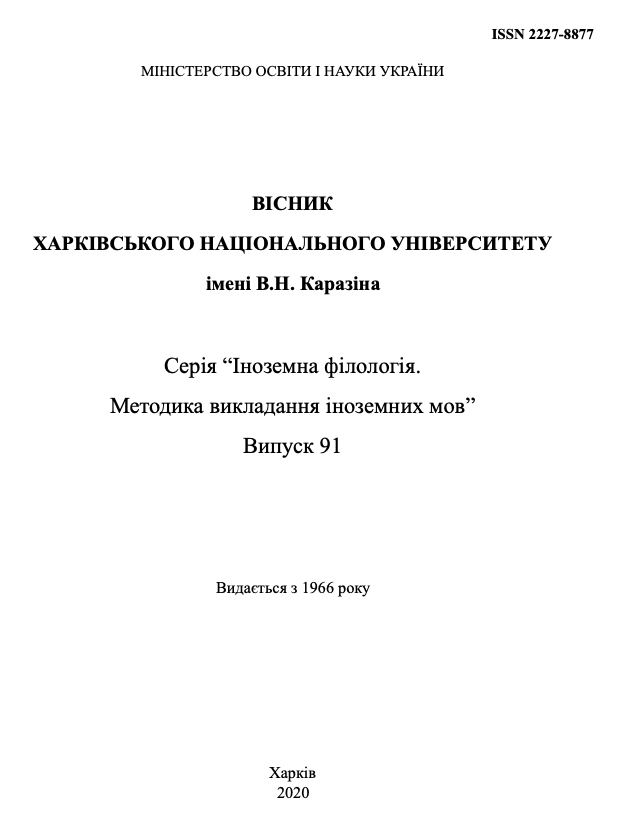Nonce words by J. Joyce in Ukrainian Translation
Abstract
The paper focuses on the specifics of reproducing nonce units coined by the author of the original literary work into Ukrainian. Nonce formations are topical and promising object of translation studies due to the whole range of reasons. First, a variety of their representations is of great interest in terms of their interpreting. In most cases, interpretation of nonce units is complicated as their morphemic structure is vague. Second, nonce units belong to the words with no direct equivalents in other languages, which greatly complicates the ways of their reproducing in the target language. Thus, dealing with each particular nonce formation in the source language, the translator has to apply non-standard approaches to selecting/coining its equivalent in the target language. So, the great contribution of the translator, his/her importance compared to that of the author of the literary work is proven. Ulysses abounds with nonce formations, making the whole piece of writing extremely challenging for translators. We classify Joyce’s nonce formations by their word-building patterns into two groups: phonographic (coined by means of combining phonemes) and morphological (coined by means of random combining morphemes or their segments). This makes it possible to conclude that the morphological structure of nonce units impacts both interpreting and coining their equivalents. However, the universal approach or strategy to their reproducing in the target language does not exist. In every case the translator should take into account the whole range of factors including but not limited to rendering pragmatic intentions of the author of the original literary work and uniqueness of his/her individual style. While reproducing nonce words of the novel Ulysses into Ukrainian, in most cases translators applied calque (loan translation) and compensation rather than transcoding. Their choice of the domestication strategy can be explained by their attempts to make one of the most difficult novels more accessible to Ukrainian readers.
Downloads
References
Bartashova, O.A. (2010). Fonosemanticheskij fond individual'nyh avtorskih konceptov [Phono-semantic stock of individual authors’ concepts]. Izvestija SPbUJeF [Messenger of Saint Petersburg State University of Economics], № 6(66), 57–62 (in Russian)
Begbeder, F. (2002). Poslednjaja inventarizacija pered prodazhej. [The last inventory checking before selling]. Inostrannaja literatura [Foreign Literature]. № 4. Available at: http://magazines.russ.ru/inostran/2002/4 (in Russian)
Voronina, K.V., Kotova, A.V. (2016) Okazional`ni utvorennya yak element idiosty`lyu Dzh. Dzhojsa. S`omy`j mizhnarodny`j naukovy`j forum. Suchasna inozemna filologiya: doslidny`cz`ky`j potencial. Tezy` dopovidej u 2-x ch., 23 November 2016 Kharkiv [Proc. 7th Int. Forum 23 November 2016, Kharkiv], Kharkiv, 47–49.
Genieva, E. (1982). Perechityvaem Dzhojsa. [Rereading Joyce]. Dzhojs D. Dublincy. Moscow : Izvestia Publ.
Goncharenko, E.P. (2015) Storinkamy` ukrayins`kogo Dzhojsa (pereklad ta analiz pershogo epizodu romanu "Uliss"). [Discovering Ukrainian Joyce (translation and analysis of the first episode of “Ulysses”)]. Naukovy`j visny`k Mizhnarodnogo gumanitarnogo universy`tetu. Ser.: Filologiya [International Humanitarian University Scientific Messenger], № 14. 240-244. (in Ukrainian)
Gorbunova, N. G. Jazykotvorchestvo Dzh. Dzhojsa: slovoobrazovatel'nyj aspekt (na primere romana "Uliss"). diss. kand. filol. nauk [J. Joyce’s language creativity: word-building aspect]. Saint Petersburg. 204 p. (in Russian).
James Joyce: silence, cunning and exile. Available at: http://www.james-joyce.ru/
Dzhojs, D. (2015). Uliss [Ulysses]. Translated from English by O. Terex and O. Mokrovol`s`ky`j Kyiv: Zhupans`ky`j Publ.
Koczarev, O. (2015). Uliss ukrayins`koyu: ne my`nulo j sta rokiv. [Ulysses in Ukrainian: finally, translated]. Available at: https://vsiknygy.net.ua/shcho_pochytaty/42965/
Rebrij, O.V. (2012) Suchasni koncepciyi tvorchosti u perekladi: monografiya [Modern concepts of creativity in translation: monograph]. Kharkiv: Kharkiv National University.
Halizev, V. E. (2003). Germenevtika (razdel 1 glavy ІІІ Funkcionirovanie literatury) [Hermeneutics (Section 1 of Chapter III Functioning of Literature)]. Teorija literatury: uchebnik. [2-e izd] [Theory of Literature: textbook]. Moscow: Vysh. Shk. Publ.
Bauer, L. (1983). English Word-Formation. Cambridge : Cambridge University Press.
Ellmann, R. (1982). James Joyce. New York, Oxford, Toronto : Oxford University Press.
Joyce, J. (1998). Ulysses. London: Picador, 1998. URL: https://www.e-reading-lib.com (дата звернення: 14.04.2020).
Kölsch, H. (2014). James Joyce: Ulysses. Norderstedt: Books on Demand GmbH.
Menand, L. (2016). Why We Are No Longer Shocked by “Ulysses”. The New Yorker. URL: https://www.newyorker.com/culture/cultural-comment/why-we-are-no-longer-shocked-by-ulysses (дата звернення: 31.03.2020)
Wu X. (2011). The Poetics of Foregrounding: The Lexical Deviation in Ulysses. Theory and Practice in Language Studies. Vol. 1, No. 9.




